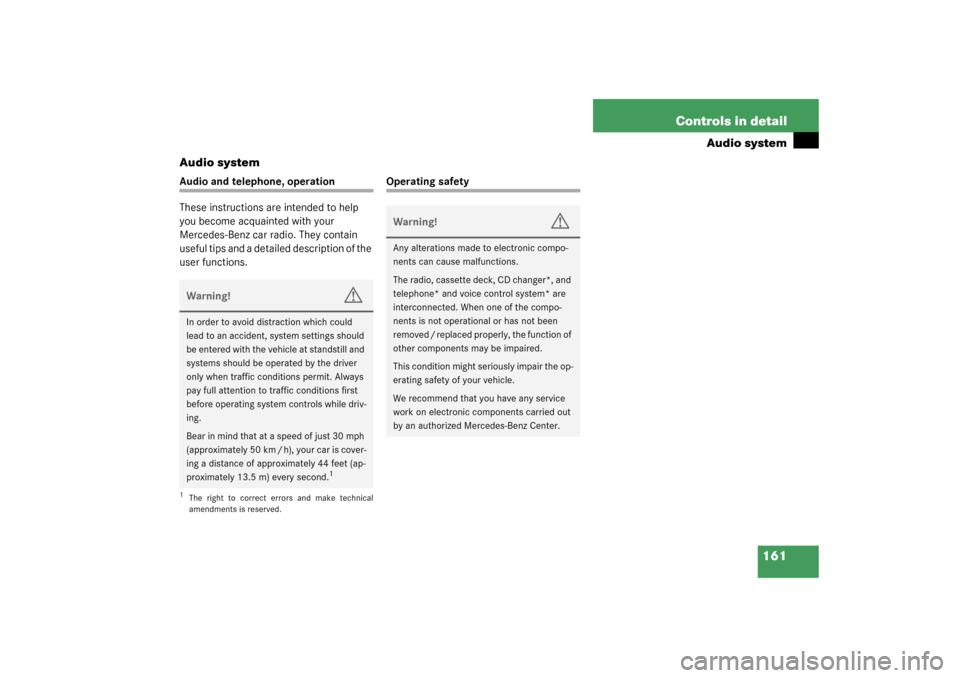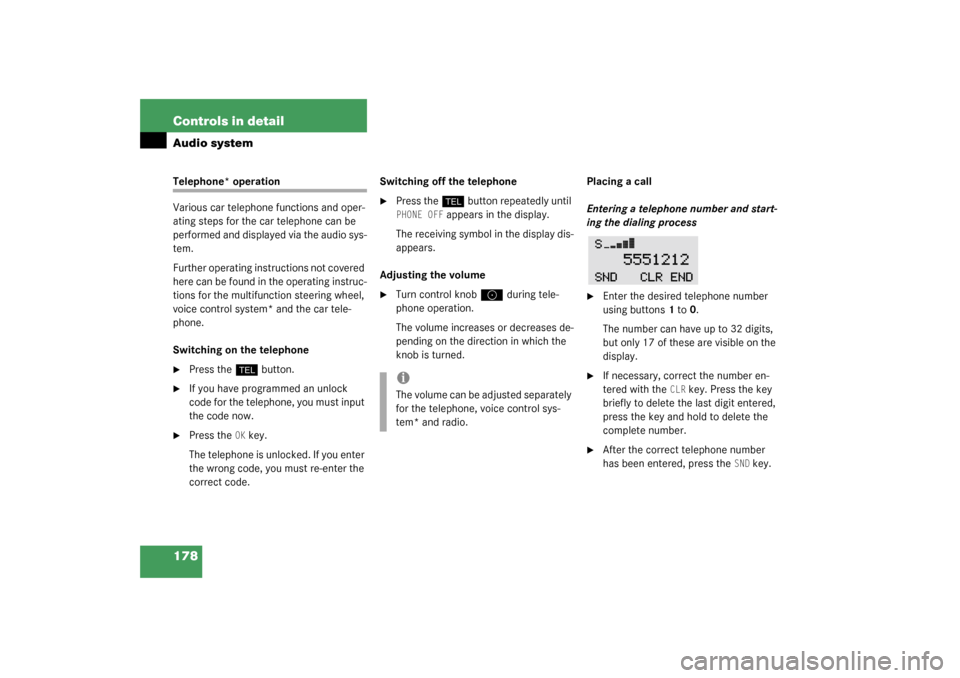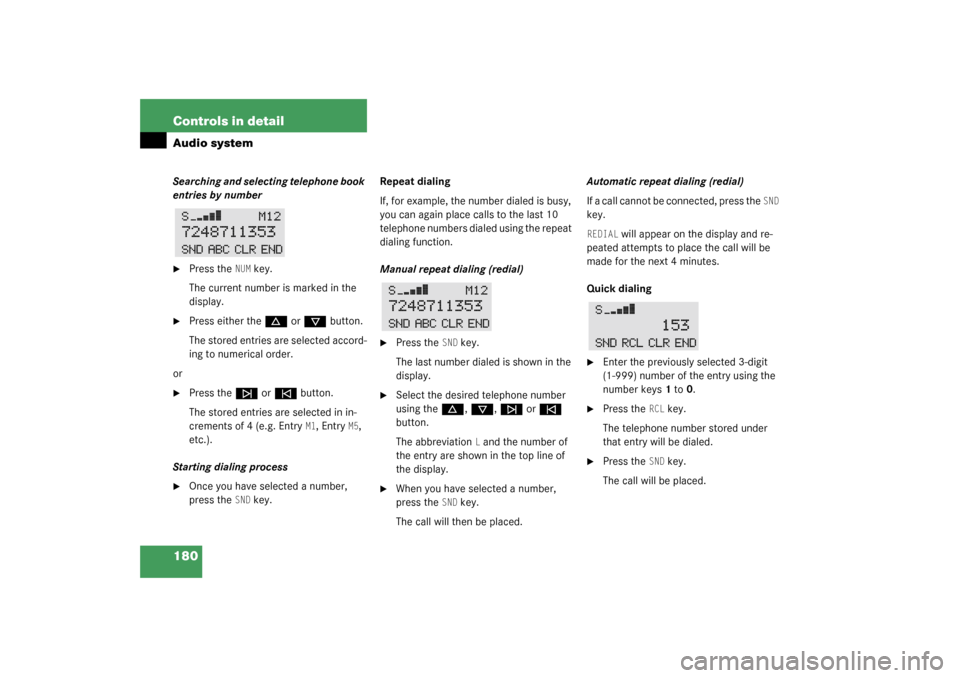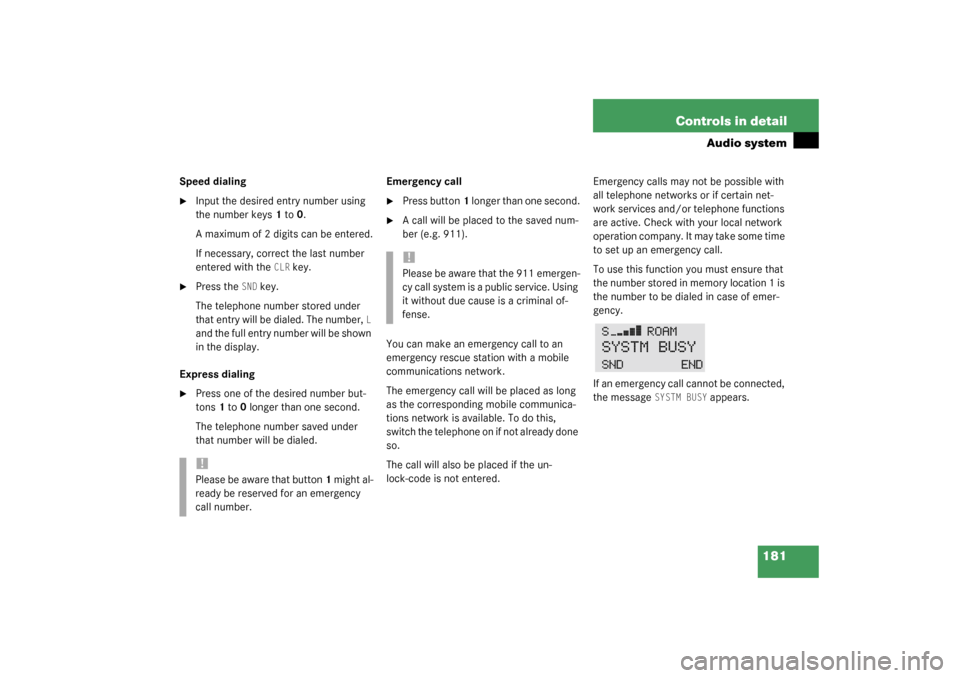Page 155 of 370

161 Controls in detail
Audio system
Audio system
Audio and telephone, operation
These instructions are intended to help
you become acquainted with your
Mercedes-Benz car radio. They contain
useful tips and a detailed description of the
user functions.
Operating safety
Warning!
G
In order to avoid distraction which could
lead to an accident, system settings should
be entered with the vehicle at standstill and
systems should be operated by the driver
only when traffic conditions permit. Always
pay full attention to traffic conditions first
before operating system controls while driv-
ing.
Bear in mind that at a speed of just 30 mph
(approximately 50 km / h), your car is cover-
ing a distance of approximately 44 feet (ap-
proximately 13.5 m) every second.
1
1The right to correct errors and make technical
amendments is reserved.
Warning!
G
Any alterations made to electronic compo-
nents can cause malfunctions.
The radio, cassette deck, CD changer*, and
telephone* and voice control system* are
interconnected. When one of the compo-
nents is not operational or has not been
removed / replaced properly, the function of
other components may be impaired.
This condition might seriously impair the op-
erating safety of your vehicle.
We recommend that you have any service
work on electronic components carried out
by an authorized Mercedes-Benz Center.
S203 MY03_A.book Page 161 Tuesday, January 28, 2003 2:22 PM
Page 157 of 370
163 Controls in detail
Audio system
Item
Page
1
CD mode selector
174
2
Manual tuning
(radio)
168
Fast forward/reverse
(cassette, CD)
172,
176
Speed dialing memory
(telephone*)
181
3
Radio mode selector
167
4
Display
Item
Page
5
Alpha-numeric keypadBand selection,
station buttons (radio)
167
CD selection (CD)
175
Telephone number entry,
retrieving speed dialing
memory (telephone*)
178
6
Scanning (radio, cas-
sette, CD)
169,
172,
176
7
Function button
168
8
Soft keys
164
Item
Page
9
Cassette eject
171
10
Cassette mode selector
170
11
Telephone* mode selec-
tor
178
12
Seek tuning (radio)
168
Track search (cassette,
CD)
171,
176
Speed dialing memory
(telephone*)
181
13
On /off
164
Volume
164
S203 MY03_A.book Page 163 Tuesday, January 28, 2003 2:22 PM
Page 158 of 370

164 Controls in detailAudio systemButton and soft key operation
In these instructions, the alpha-numeric
keypad (right side of radio face) and the
function buttons (left side of the radio
face) are referred to as “buttons” and the
four keys under the display are referred to
as “soft keys”.Operation
Switching on/off
Switching on:�
Turn the key to position 1 or 2 in the
starter switch.
or
�
Turn control knob
a
.Switching off:
�
Remove the key from the starter
switch.
or
�
Turn control knob
a
.
Adjusting the volume
�
Turn control knob
a
.
The volume will increase or decrease
according to the direction turned.Adjusting audio functions
In radio, cassette and CD mode, press the
AUD key to call up the bass, treble, bal-
ance and fader functions.
Settings for bass and treble are stored sep-
arately for the AM (medium wave, long
wave, short wave) and FM (ultra-short
wave) frequency bands, cassette mode
and CD mode.
iDo not press directly on the radio dis-
play face.
iIf the radio is turned on without the key
in the ignition, it will automatically turn
off again after approx. 30 minutes.
iIf your vehicle was equipped with a
telephone* and voice control system*,
and both are connected to the car ra-
dio, their volume can be adjusted sepa-
rately while the telephone* is being
used or voice control system* is acti-
vated.
S203 MY03_A.book Page 164 Tuesday, January 28, 2003 2:22 PM
Page 161 of 370

167 Controls in detail
Audio system
You can select from among the follow-
ing settings:�
DRV
: The tone level is set to the
“Driver” position, sound is directed
toward the passengers.
�
SP: The tone level is set for
“Speech”, optimizing the sound for
spoken language.
�
AMB
: The tone level is set for “Ambi-
ence”, producing a three-dimen-
sional sound.
�
OFF
: The audio system sound selec-
tion is turned off.
Telephone* muting
If a telephone has been installed in the ve-
hicle, the radio will switch to telephone
mode when a call is received. The current
audio source is muted.
Radio mode
Selecting radio mode�
Press the
b
button.
Selecting the band
You can select from among FM, AM or WB
frequency bands.
FM frequency band:
FM (ultra-short wave) 87.9......107.9 MHz
AM frequency bands:
MW (medium wave) 530......1710 KHz
WB (long wave) approx. 162 KHzSelecting FM band
�
Press the
FM function button.
FM appears in the upper right-hand cor-
ner of the display.
Selecting AM band
�
Press the
AM function button.
AM appears in the upper right-hand cor-
ner of the display.
Selecting a station
The following options are available for se-
lecting a station:
�
Direct frequency band input
�
Manual tuning
�
Automatic seek tuning
�
Scan tuning
�
Station buttons
�
Automatic station memory (Autostore)
S203 MY03_A.book Page 167 Tuesday, January 28, 2003 2:22 PM
Page 172 of 370

178 Controls in detailAudio systemTelephone* operation
Various car telephone functions and oper-
ating steps for the car telephone can be
performed and displayed via the audio sys-
tem.
Further operating instructions not covered
here can be found in the operating instruc-
tions for the multifunction steering wheel,
voice control system* and the car tele-
phone.
Switching on the telephone�
Press the
h
button.
�
If you have programmed an unlock
code for the telephone, you must input
the code now.
�
Press the
OK key.
The telephone is unlocked. If you enter
the wrong code, you must re-enter the
correct code.Switching off the telephone
�
Press the
h
button repeatedly until
PHONE OFF
appears in the display.
The receiving symbol in the display dis-
appears.
Adjusting the volume
�
Turn control knob
a
during tele-
phone operation.
The volume increases or decreases de-
pending on the direction in which the
knob is turned.Placing a call
Entering a telephone number and start-
ing the dialing process
�
Enter the desired telephone number
using buttons 1 to 0.
The number can have up to 32 digits,
but only 17 of these are visible on the
display.
�
If necessary, correct the number en-
tered with the
CLR
key. Press the key
briefly to delete the last digit entered,
press the key and hold to delete the
complete number.
�
After the correct telephone number
has been entered, press the
SND
key.
iThe volume can be adjusted separately
for the telephone, voice control sys-
tem* and radio.
S203 MY03_A.book Page 178 Tuesday, January 28, 2003 2:22 PM
Page 173 of 370

179 Controls in detail
Audio system
Telephone book
The numbers stored in the telephone book
c a n b e c a l l e d u p b y e i t he r n a m e o r n u m b e r .
Calling up the telephone book�
Press either the
d
, c
, f
or
e
button.
Switching between name search and
number search
�
Press the
ABC
key.
The name search is called up.
or
�
Press the
NUM
key.
The number search is called up.Searching and calling up telephone book
entries by name
�
Press the
ABC
key.
The current name is marked on the dis-
play.
�
Press either the
d
or
c
button.
The stored entries are selected accord-
ing to alphabetical order of initial let-
ters.or
�
Press the
f
or
e
button.
The stored entries are selected in in-
crements of 4.
or
�
Press the desired numerical key 2 to 9.
The stored entries are selected accord-
ing to alphabetical initial letters (e.g.
for
B-Brown, press button 2 twice).
iA number of characters and symbols
cannot be shown on the display for
technical reasons, they have been re-
placed with spaces.
S203 MY03_A.book Page 179 Tuesday, January 28, 2003 2:22 PM
Page 174 of 370

180 Controls in detailAudio systemSearching and selecting telephone book
entries by number�
Press the
NUM
key.
The current number is marked in the
display.
�
Press either the
d
or
c
button.
The stored entries are selected accord-
ing to numerical order.
or
�
Press the
f
or
e
button.
The stored entries are selected in in-
crements of 4 (e.g. Entry M1, Entry
M5,
etc.).
Starting dialing process
�
Once you have selected a number,
press the
SND
key.Repeat dialing
If, for example, the number dialed is busy,
you can again place calls to the last 10
telephone numbers dialed using the repeat
dialing function.
Manual repeat dialing (redial)
�
Press the
SND
key.
The last number dialed is shown in the
display.
�
Select the desired telephone number
using the
d
, c
, f
or
e
button.
The abbreviation
L and the number of
the entry are shown in the top line of
the display.
�
When you have selected a number,
press the
SND
key.
The call will then be placed.Automatic repeat dialing (redial)
If a call cannot be connected, press the
SND
key.
REDIAL
will appear on the display and re-
peated attempts to place the call will be
made for the next 4 minutes.
Quick dialing
�
Enter the previously selected 3-digit
(1-999) number of the entry using the
number keys 1 to 0.
�
Press the
RCL
key.
The telephone number stored under
that entry will be dialed.
�
Press the
SND
key.
The call will be placed.
S203 MY03_A.book Page 180 Tuesday, January 28, 2003 2:22 PM
Page 175 of 370

181 Controls in detail
Audio system
Speed dialing�
Input the desired entry number using
the number keys 1 to 0.
A maximum of 2 digits can be entered.
If necessary, correct the last number
entered with the
CLR
key.
�
Press the
SND
key.
The telephone number stored under
that entry will be dialed. The number,
L
and the full entry number will be shown
in the display.
Express dialing
�
Press one of the desired number but-
tons 1 to 0 longer than one second.
The telephone number saved under
that number will be dialed.Emergency call
�
Press button1 longer than one second.
�
A call will be placed to the saved num-
ber (e.g. 911).
You can make an emergency call to an
emergency rescue station with a mobile
communications network.
The emergency call will be placed as long
as the corresponding mobile communica-
tions network is available. To do this,
switch the telephone on if not already done
so.
The call will also be placed if the un-
lock-code is not entered.Emergency calls may not be possible with
all telephone networks or if certain net-
work services and/or telephone functions
are active. Check with your local network
operation company. It may take some time
to set up an emergency call.
To use this function you must ensure that
the number stored in memory location 1 is
the number to be dialed in case of emer-
gency.
If an emergency call cannot be connected,
the message
SYSTM BUSY
appears.
!Please be aware that button 1 might al-
ready be reserved for an emergency
call number.
!Please be aware that the 911 emergen-
cy call system is a public service. Using
it without due cause is a criminal of-
fense.
S203 MY03_A.book Page 181 Tuesday, January 28, 2003 2:22 PM